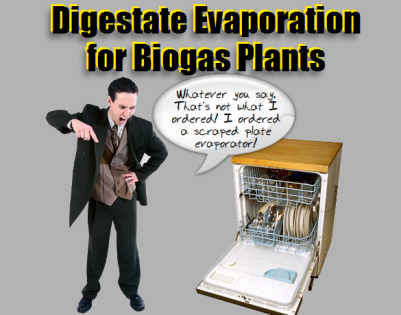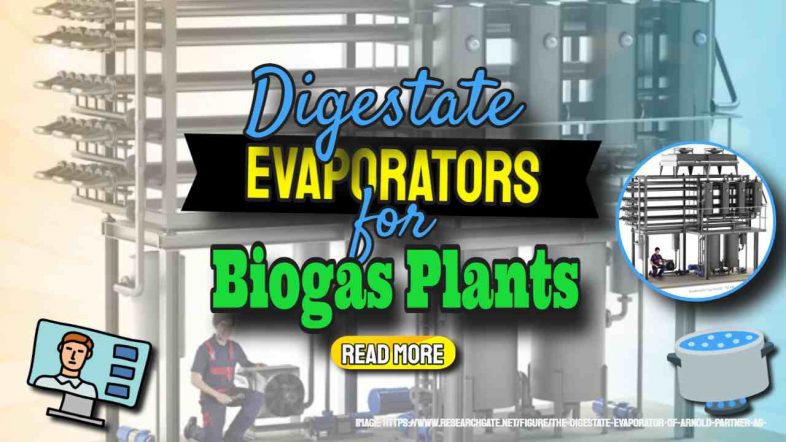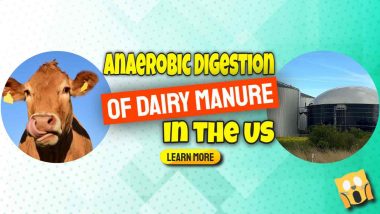How Digestate Evaporators for Anaerobic Digestion Plants add product value and aid organic waste disposal.
Liquid digestate (LD) is a product of mechanical digestate separation that contains significant nutrients as well as a lot of water. As a result, treating the LD is quite costly for the plant owners. Vacuum evaporation is one method for draining the LD and obtaining valuable concentrated nutrients.
In this article, we consider the recent developments in liquid digestate evaporation technology, where evaporators can be used to:
- improve the marketability of the liquid digestate output from biogas plants by heat pasteurisation, or
- reduce disposal costs by reducing the volume of the digestate for disposal when the digestate is not suitable for use as a bio-fertilizer
- produce an “added value” crystalline digestate. This is lighter to transport and as a result marketable to a larger market. This happens both in a larger geographical area and to a wider type of user market.
Digestate Evaporators – Key Takeaways
- Efficiency and Energy Use: Digestate evaporators enhance the efficiency of anaerobic digestion plants by reducing the volume of liquid digestate and converting it into distilled water and a concentrated residue. Using vacuum systems lowers energy consumption by reducing the boiling point of the liquid.
- Economic Benefits: Investing in digestate evaporation technology can lead to a positive return on investment (ROI) within one to two years. This is due to reduced disposal costs and the potential sale of byproducts.
- Environmental Impact: The process aids in achieving zero liquid discharge (ZLD), transforming waste streams into clean water and valuable byproducts, thus minimizing environmental pollution and enhancing sustainability.
- Technological Solutions: Different types of industrial evaporators, such as scraped surface heat exchangers and vacuum evaporators, are used to treat digestate. These technologies are integrated into biogas plants to maximize the use of waste heat and reduce fossil fuel dependency.
- Regulatory Compliance: Digestate drying and concentration meet strict EU regulations for environmental protection and hygiene, making the process more acceptable to local communities and reducing the risk of water pollution.
Disadvantages of Raw Liquid Digestate for Sale
Digestate in its raw form straight from the digester, is a heavy form of fertilizer, to transport to markets. It's mostly just water. The result of that is to make it expensive to deliver to any markets remote from the biogas plant.
The raw liquid digestate is seldom transported more than a few farms away from its place of origin. When buying digestate fertilizer local framers are not slow to realize that biogas plant operators have few buyers.
They know that usually these are limited to the neighbouring farms. Some farmers may just decide to play a waiting game. They wait, assuming that if they hold out saying they are not willing to pay, the plant operator may one day need to offer this valuable fertilizer to them for free.
Advantages of Evaporation to Produce Concentrated and Crystalline Digestate
The sale of digestate in its much lighter and more concentrated crystalline form, after evaporation, may make very good commercial sense.
One of the most promising paths toward completely utilising green energy within a circular economy is biogas generation.
Because of its low energy consumption and reliance on bacteria, anaerobic digestion is the industry-standard technology for biogas production.
Digestate Suitable as a Fertilizer for Food Crop Use
If the digestate is created in a region abundant in AD Plants such as an intensive dairy farming region and sold for fertilizer use on arable land, care will be needed to avoid nitrogen build-up and possibly contaminant accumulation in soils.
By reducing the water content of digestate during evaporation a much wider market can be supplied. The resulting prices obtained will usually be much better.
Digestate Not Suitable for Agricultural Use
CHP as the Heat Source for Evaporation
 Finally, before we go into more depth on this subject, and before any reader leaves due to cost worries about the admittedly very substantial energy use evaporation technology. Remember that there is a source of cheap heat at every AD plant.
Finally, before we go into more depth on this subject, and before any reader leaves due to cost worries about the admittedly very substantial energy use evaporation technology. Remember that there is a source of cheap heat at every AD plant.Digestate Evaporators for Anaerobic Digestion Plants Add Product Value and Aid Disposal
Instead of simply disposing of organic waste material, it is placed into a biodigester, where microbes break down the organic matter, producing methane (biogas) in the process.
Biogas can be used to generate electricity or to power vehicles, the latter offering the highest returns for biogas plant operators.
However, the output of “digestate” must be used on-site, sold, or treated prior to responsible disposal.
One method which can be used as a form of treatment for digestate is evaporation which is achieved in varying ways.
CHP as the Heat Source for Evaporation
Heat exchangers are capable of recovering heat from other sources, such as the heat left from a biogas plant CHP Engine or from pasteurisation.
Using this as the foundation for an evaporation system can enhance the overall efficiency of the operation. Furthermore, using a vacuum in the system to lower the boiling point lowers the amount of energy required even more.
Heat exchangers that can recover heat from alternative “greener” and more sustainable sources might be provided. These include residual heat from a CHP engine or pasteurisation. Using this alternate heat source as the foundation for an evaporation system can increase the overall efficiency of the process.
Furthermore, using a vacuum in the system to lower the boiling point lowers the amount of energy required even more.
Why Invest in a Scraped Surface Evaporation Plant?
In digestate evaporation plants, scraped surface heat exchangers, such as those made by HRS heat exchangers, are employed.
The pricing point is such that the manufacturer claims it enables a quick return on investment.
Positive ROI can be reached in as little as two years in some circumstances.
We understand that the DCS (digestate concentration system) can generate net positive cash flow after one or two years of commissioning.
Thickening of Liquid Digestate: Integration of Vacuum Evaporator into a Biogas Plant
Vacuum evaporation is a cost-effective method for reducing the volume of liquid digestate (LD) produced by biogas plants (BGP).
In addition, thickening LD in a BGP helps to maximise the use of waste heat while reducing the quantity of fossil fuel necessary to transport LD.
On the other hand, the economic case for vacuum evaporation must be well-founded. Before introducing evaporation technology into a specific BGP, always conduct an assessment. Each project's cost-benefit analysis will differ, thus a comprehensive examination is required.
This article looks at some of the settings for three different types of industrial evaporators that could be used for LD thickening.
Wastewater Treatment Plant Evaporator
The end product of anaerobic digestion (AD) is digestate. Vacuum evaporation plants are used for the concentration of thermolabile solutions such as digestate.
A wastewater treatment plant solution was sought by a collector of municipal waste, for previously separated, and different sludges from a wastewater treatment plant. Through a complete treatment process, the client's plant produces biogas and compost.
The client’s request was to find a solution to treat the digestate they have, coming from the biogas production process, and to obtain clean water for internal process use, thus reducing the costs for discharge.
An evaporative wastewater treatment process was tested by an independent group for effectiveness in certain applications. It was concluded that evaporation would be a viable treatment method in many cases.
Certainly, for many biogas plants, the digestate can be condensed with an evaporator and thanks to the usually present steam, an evaporator with an external heat supply can be chosen.
The Goal is Zero Liquid Discharge (ZLD)
Zero liquid discharge (ZLD) involves transforming liquid waste streams from industrial plants into clean water, which can be reused in the process. This entails removing the solid residues, which often include valuable byproducts that can then be sold or reused.
Although every ZLD system is different, many comprise:
- a pretreatment phase,
- an evaporation phase to remove most of the water, and a
- further concentration or crystallization phase to produce the final solid residue.
The rising number of biogas plants (BGP) is associated with a rising amount of digestate, which is a by-product of biogas production.
The best system for saline solution purification such as digestate is evaporation. This can be able to produce up to 70-90% of distilled water and 30-10% of the concentrate.
Zero liquid discharge (ZLD) involves transforming liquid waste streams from industrial plants into clean water, which can be reused in the Digestate Evaporators process.
The minimum amount of solid residues, which often include valuable byproducts, can then be sold or reused. Although every ZLD system will be different, many will comprise:
- a pre-treatment phase,
- an evaporation phase to remove most of the water, and
- a further concentration or crystallization phase to produce the final solid residue.
In many cases for digestate evaporators, the environmental authorities do not allow any discharge to the river or ask such high COD, BOD, n, p, or colour removal rates that costs are high.
If not for evaporation technology the wastewater treatment plant’s CAPEX and OPEX would make the business uncompetitive without evaporation.
Multiple Effect Evaporator Plant
Bio Enviro Solutions is one of the well-distinguished companies in the market and is a business that commenced in the year 2009 as a sole proprietorship-based firm.
The headquarters of the corporation is located in Bengaluru, Karnataka.
Bio Enviro Solutions is a prominent manufacturer, engaged in offering a quality-tested assortment of:
- treatment plant,
- water treatment chemical,
- bio enzyme,
- the biogas plant, RO water plant and multiple-effect evaporator plants.
Vacuum evaporation treatment of digestate: Full exploitation of cogeneration heat
In places with high livestock density, vacuum evaporation is an intriguing and unique approach for controlling animal waste surpluses.
A crucial aspect in lowering operational costs is the availability of a low-cost supply of heat, such as that produced by an anaerobic digestion (AD) plant.
The goal of this study was to see how well vacuum evaporation worked for treating cattle slurry digestate, with a focus on heat extraction. The experiments were carried out on a pilot plant that was fed digestate from a full-scale ad plant.
Liquid digestate is still created from the leftovers of digested bio-feedstock and will require treatment even in such an environmentally beneficial procedure.
The bulk of bio-feedstock would potentially escape the circular supply chain within the economy if an improper treatment process for liquid digestate is used.
Nevertheless, it was concluded that vacuum evaporation was a well-tested and successful treatment technology.
The following sections contain the content of our original article first posted in September 2013:
Your comments are welcome on this rapidly developing Anaerobic Digestion (AD) subject area, so please give us your thoughts on using Digestate Evaporators for Anaerobic Digestion Plants to Add Product Value and Aid Disposal.
Digestate Evaporators – FAQs
Q1: What is digestate and how is it produced?
A1: Digestate is a nutrient-rich byproduct of the anaerobic digestion process, which breaks down organic matter to produce biogas. It consists of leftover indigestible material and dead microorganisms.
Q2: Why are digestate evaporators important in anaerobic digestion plants?
A2: Digestate evaporators reduce the volume of liquid digestate, making it easier and more cost-effective to handle and dispose of. They also produce clean water and concentrated byproducts that can be used or sold, enhancing the overall efficiency and profitability of the plant.
Q3: What are the environmental benefits of using digestate evaporators?
A3: Using digestate evaporators contributes to zero liquid discharge (ZLD), reducing the environmental impact by minimizing waste and pollution. It also helps manage ammonia emissions and meet strict environmental regulations.
Q4: How do digestate evaporators contribute to economic savings?
A4: Digestate evaporators reduce disposal costs and create valuable byproducts that can be sold. The investment in these systems often pays off within one to two years, leading to positive cash flow and profitability.
Q5: What types of technologies are used in digestate evaporation?
A5: Various technologies, including vacuum evaporation and scraped surface heat exchangers, are employed. These technologies maximize the use of waste heat, reduce energy consumption, and ensure a high-quality digestate that is easy to sell.
[This article was first published in September 2013: Previous update 6 June 2021. Current update 18 July 2024]
Evaporator image used in featured image: www.researchgate.net





We are a global supplier of all kinds of Industrial equipment for different industrial purposes including industries. We provide professional services and guide the operators on achieving cost-friendly solutions by increasing efficiency. we have a website at processing equipment services